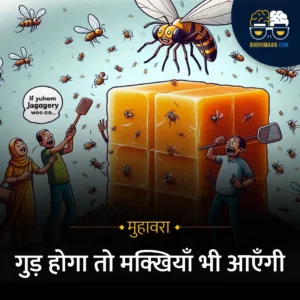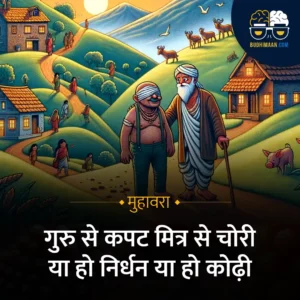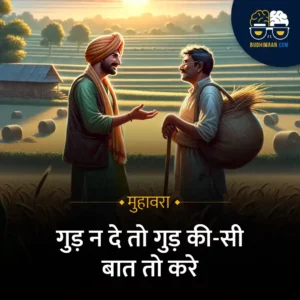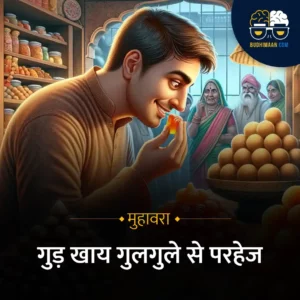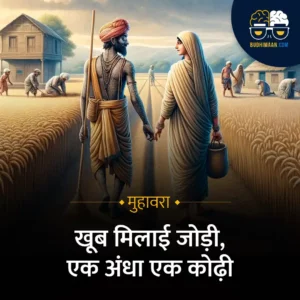परिचय: एक तो करेला दूजे नीम चढ़ा, जीवन में कभी-कभी ऐसे हालात आ जाते हैं जब एक समस्या का सामना कर ही रहे होते हैं कि दूसरी समस्या भी सिर पर आ खड़ी होती है।
अर्थ: इसका अर्थ है कि एक बुरी स्थिति में पहले से ही जूझ रहे होते हैं, और फिर एक और नकारात्मक परिस्थिति उसमें जुड़ जाती है। करेला स्वयं में कड़वा होता है और जब उस पर नीम की पत्तियों का लेप लगा दिया जाए, जो कि स्वयं में और भी कड़वी होती हैं, तो स्थिति और भी अधिक कष्टकारी हो जाती है।
इस मुहावरे का इस्तेमाल आमतौर पर उन परिस्थितियों में किया जाता है, जब एक व्यक्ति पहले से ही किसी कठिनाई या नकारात्मक स्थिति में होता है, और तब कोई और विपत्ति उस पर आ पड़ती है। उदाहरण के लिए, यदि किसी व्यक्ति को नौकरी से हाथ धोना पड़ा हो और उसी समय उसकी स्वास्थ्य स्थिति भी बिगड़ जाए, तो इस स्थिति को “एक तो करेला दूजे नीम चढ़ा” कहा जा सकता है।
उदाहरण:
-> “अभय की पहले से ही कुछ वित्तीय समस्याएँ थीं, और ऊपर से उसकी कार भी खराब हो गई, सच में ‘एक तो करेला दूजे नीम चढ़ा’ वाली स्थिति हो गई।”
निष्कर्ष: यह मुहावरा हमें यह भी सिखाता है कि जीवन में जब एक के बाद एक मुसीबतें आएं, तो संयम और धैर्य के साथ काम लेना चाहिए। अक्सर ऐसे में व्यक्ति की परीक्षा होती है और उसका सच्चा चरित्र सामने आता है।
अतः, “एक तो करेला दूजे नीम चढ़ा” हमें यह बताता है कि कठिन समय में भी आशावादी रहना और समस्याओं का सामना करना ही वास्तविक बुद्धिमत्ता है।

एक तो करेला दूजे नीम चढ़ा मुहावरा पर कहानी:
एक छोटे से गांव में सुरेंद्र नाम का एक किसान रहता था। वह अपनी मेहनत और लगन से अपने खेतों को हरा-भरा रखता था। लेकिन एक वर्ष, अकाल पड़ने के कारण उसकी फसल बर्बाद हो गई। वह पहले से ही परेशान था कि उसकी गाय भी बीमार पड़ गई। उसकी यह स्थिति देखकर गांव के बुजुर्ग ने कहा, “बेटा, तुम्हारी तो ‘एक तो करेला दूजे नीम चढ़ा’ वाली बात हो गई है।”
सुरेंद्र ने बुजुर्ग की बात सुनी और सोचा कि सचमुच उसकी मुसीबत दोगुनी हो गई है। एक ओर तो सूखे ने उसके खेत को बंजर बना दिया था, और दूसरी ओर उसकी गाय की बीमारी ने उसे और चिंतित कर दिया था। लेकिन सुरेंद्र ने हिम्मत नहीं हारी। उसने सोचा, “यह समय भी चला जाएगा, मुझे धैर्य रखना होगा।”
उसने गांव के डॉक्टर से गाय का इलाज करवाया और खेती के लिए बारिश की प्रतीक्षा की। धीरे-धीरे, बारिश आई और उसकी खेती फिर से हरी-भरी हो गई। गाय भी स्वस्थ हो गई। सुरेंद्र ने सीखा कि जीवन में कठिनाइयां तो आती रहती हैं, लेकिन उन्हें सहन करने और उनसे पार पाने की शक्ति भी हम में होती है।
इस तरह, सुरेंद्र की कहानी ने उस मुहावरे ‘एक तो करेला दूजे नीम चढ़ा’ का अर्थ समझाया और यह भी दिखाया कि कैसे सकारात्मक सोच और कड़ी मेहनत से कठिन समय को भी मात दी जा सकती है।
शायरी:
मुश्किलें जब हद से बढ़ जाएं, ‘करेला’ भी फीका पड़ जाए,
जिंदगी जब नीम पे चढ़ जाए, हर खुशी मुंह मोड़ जाए।
लेकिन ये दिल है कि मानता नहीं, उम्मीदों की कश्ती बांधता नहीं,
एक तो करेला दूजे नीम चढ़ा, फिर भी जीत की जिद पर अड़ा।
गम का ओढ़ कर जामा, हम चलते रहे बेपरवाह,
‘करेला’ संग ‘नीम’ की चादर, बन गई तकदीर की राह।
ना माना हार को, ना थमे थे कदम,
इसी जज्बे ने तो खुद को, बनाया है हम।
हर घड़ी को यूंही सजाया हमने, हर मुश्किल से वफा की,
एक तो करेला दूजे नीम चढ़ा’, फिर भी मोहब्बत से जीता हमने।
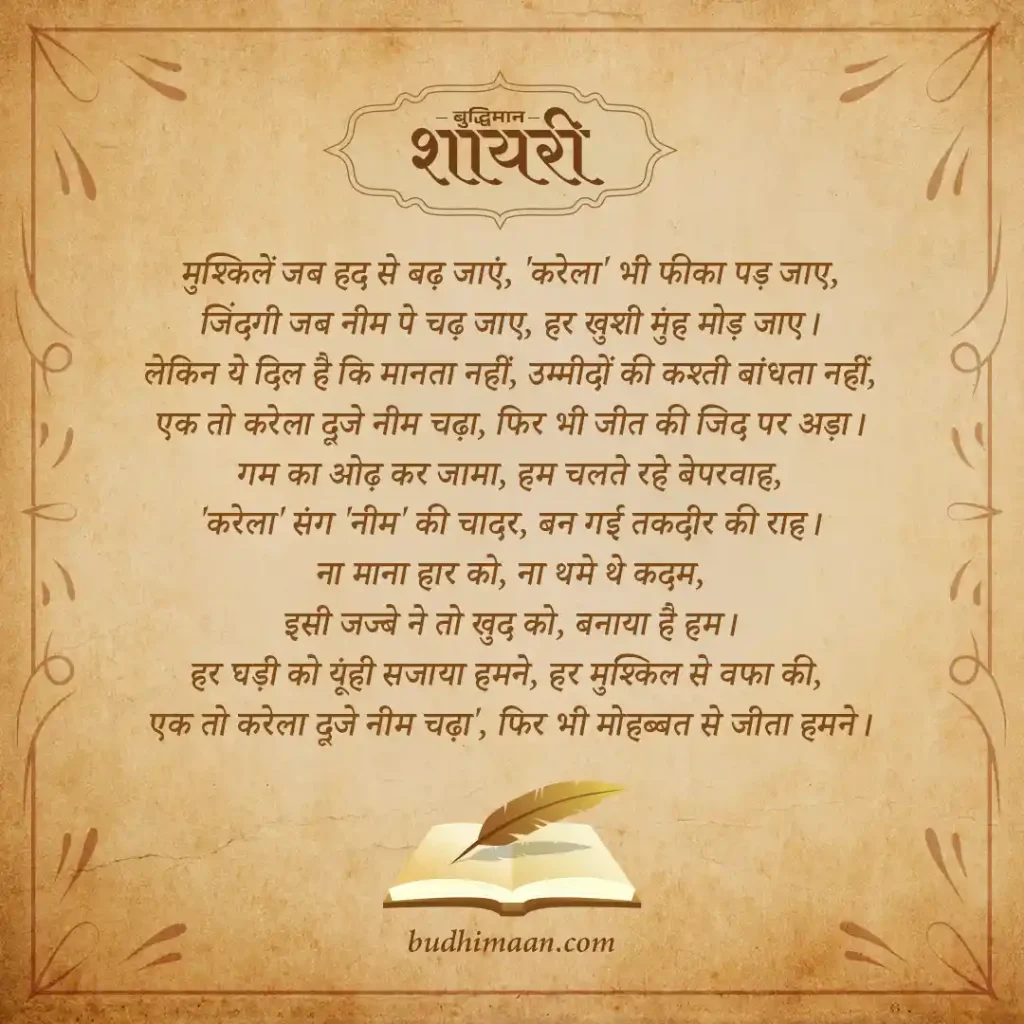
आशा है कि आपको इस मुहावरे की समझ आ गई होगी और आप इसका सही प्रयोग कर पाएंगे।
Hindi to English Translation of एक तो करेला दूजे नीम चढ़ा – Ek to karela, dooje neem chadha Idiom:
Introduction: In life, sometimes situations arise when we are already facing one problem and another one crops up. To depict this experience, there is a Hindi proverb – “Ek to karela, dooje neem chadha.”
Meaning: This means when already struggling with a bad situation, another negative circumstance adds to it. Bitter gourd (karela) is bitter on its own, and when neem leaves, which are even more bitter, are applied on it, the situation becomes even more distressing.
This proverb is usually used in scenarios when a person is already in some difficulty or negative situation, and then another calamity befalls them. For instance, if someone loses their job and simultaneously their health deteriorates, this situation can be described as “Ek to karela, dooje neem chadha.”
Examples:
-> “Abhay was already facing some financial problems, and to top it off, his car broke down as well; it truly became a ‘Ek to karela, dooje neem chadha’ situation.”
Conclusion: This proverb also teaches us that when troubles come one after another in life, one should act with composure and patience. Often in such times, a person is tested, and their true character comes to light.
Therefore, “Ek to karela, dooje neem chadha” tells us that maintaining optimism and facing problems head-on is the real wisdom during tough times.
Story of Ek to karela, dooje neem chadha Idiom in English:
In a small village lived a farmer named Surendra. He kept his fields lush and green through his hard work and dedication. However, one year, due to drought, his crops were ruined. To make matters worse, his cow fell ill. Seeing his situation, an elder of the village said, “Son, it’s like ‘adding neem to bitterness’ for you.”
Surendra listened to the elder and thought indeed his troubles had doubled. On one hand, the drought had turned his fields barren, and on the other, his cow’s illness had him worried. But Surendra did not lose heart. He thought, “This time will pass too, I must be patient.”
He got his cow treated by the village doctor and waited for the rains for his farming. Gradually, the rain came, and his fields became green again. The cow also recovered. Surendra learned that difficulties come in life, but we also have the power to endure and overcome them.
Thus, Surendra’s story explained the meaning of the idiom ‘adding neem to bitterness’ and also showed how positive thinking and hard work can overcome even the toughest times.
I hope this gives you a clear understanding of the proverb and how to use it correctly
FAQs:
इस मुहावरे का उपयोग किस प्रकार से होता है?
इसे विशेषकर विस्थार से किसी स्थिति या समस्या का सामना करते हुए उपयोग किया जाता है।
“एक तो करेला दूजे नीम च” मुहावरे का मतलब क्या है?
यह मुहावरा दो कठिनाईयों का सामना करना या दो दुखों का साथ देना का अर्थ है।
क्या इसका कोई सांस्कृतिक अर्थ है?
नहीं, यह मुहावरा भाषा का ही एक खास प्रकार है और इसका कोई सांस्कृतिक अर्थ नहीं होता।
क्या इस मुहावरे का कोई वास्तविक रूप है?
नहीं, यह मुहावरा केवल भाषा कला का हिस्सा है और इसका कोई वास्तविक रूप नहीं होता है।
इसे वाक्य में कैसे शामिल किया जा सकता है?
“जीवन में एक तो करेला दूजे नीम च, हर कदम पर नए चुनौतियों का सामना करना पड़ता है।”
हिंदी मुहावरों की पूरी लिस्ट एक साथ देखने के लिए यहाँ क्लिक करें
यह मुहावरा अंकों पर आधारित मुहावरे पेज पर भी उपलब्ध है।



